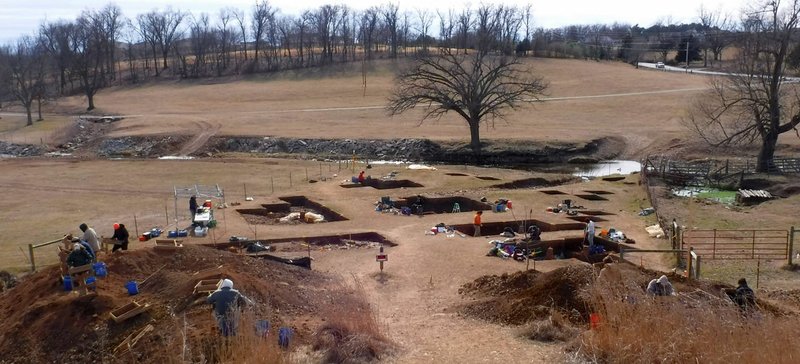It was the end of the Ice Age, some 10,500 years ago, when groups of hunters and gatherers stopped in what would become Fayetteville. These early people came to quarry materials to make stone tools, says Pritam Chowdhury, the project field director.
Archaeologists from Flat Earth Archeology in Cabot excavated from October to March a site which soon will be covered by Rupple Road. They will speak about the project to the members of the Ko-ko-ci Chapter of the Arkansas Archeological Society at 7 p.m. May 8 in the Arkansas Archeological Survey building in Fayetteville.
Go & Do
Archaeologists speak
When: 7 p.m. May 8
Where: Arkansas Archeological Survey building, 2475 N. Hatch Ave. in Fayetteville
Sponsor: Ko-ko-ci Chapter of the Arkansas Archeological Survey
Information: (479) 283-5720
"We did not find much evidence that it was a long-term habitat, such as buildings or hearths," Chowdhury says. "It was a short-term camp. They came to quarry the local 'chert' gravels and cobbles available at the site."
The site was low in the valley along Hamestring Creek, close to the flood plain which often changed the course of the stream. During that time period in history, the area was experiencing major fluctuations in climate -- from extreme heat to extreme cold, heavy rains to drought, Chowdhury says. "Things were probably harsh on the people because things were changing."
The artifacts recovered in Fayetteville generally date back to the Middle to Late Archaic period, 6,000 to 1,000 years ago, Chowdhury says. But they also recovered some early 20th century pieces -- like nails and glassware -- that probably were "trash" from agricultural activities on the site in the 1930s.
Most of the artifacts recovered have not been cataloged, Chowdhury says. He estimated the 25 or so archaeologists and technicians collected "tens of thousands" of pieces from about a quarter acre of land. All will be curated by the Arkansas Archeological Survey in Fayetteville.
"I think we got the majority of them," Chowdhury continued. "It's impossible to expect to get 100 percent of them."
He says they did collect enough artifacts to answer a lot of their research questions. "The core conclusion was that the area was very attractive for hunter-gatherers for over 10,000 years. It was a source for stone tool resources and a short-term camp," Chowdhury says. "I think we found some important information for the people of Fayetteville.
"There were so many exciting finds, each one so special," adds Chowdhury, who says he still feels excited and humbled when he's holding something that hasn't been held for so long.
He spoke of a point developed by the Calf-Creek culture, whose people traveled around the Ozarks and surrounding regions approximately 7,500 to 4,000 years ago. "They had a unique way of making stone points with a deep inset notch," he says. "No other group made a flint knap like that in North America."
And one piece of charcoal submitted for accelerated mass spectrometer dating was shown to be 3,180 years old, plus or minus 30 years, Chowdhury says. He hopes other pieces can be submitted and returned from different eras.
Archeologists also hope bone pieces recovered can reveal what these earliest Americans ate.
The archaeologists found artifacts as deep as 5 feet below the ground surface, but these probably weren't where they were left, Chowdhury says. He says the flooding of the creek churned the subsoil, and the deeper artifacts were found in root cracks created as the land dried.
When the city of Fayetteville decided to expand Rupple Road, funding from the Arkansas Department of Transportation required archeological and environmental studies before the project was finalized. In 2014, a field shovel test revealed a large archeological deposit. Test excavations in 2015 revealed the sight was intact and significant. When it was determined the road could not be moved, the full excavation was planned, Chowdhury explains.
NAN Profiles on 05/06/2018

